Summernats announcer Kerry Digney regales us with further tall tales from his misspent youth
LAST time, Kerry Digney, voice of Summernats and Powercruise, shared some anecdotes from his younger years spent in the colourful environs of the 1960s and early 70s Sydney street racing scene. Well, he’s back with more, taking us from the end of his time in Sydney through to his move to Queensland in the early 70s and the motorsport-announcing apprenticeship he received under the late, great Milton Adey.
“So you really want to know about how a lot of grandfathers and grandmothers used to spend their mid-week nights?” he laughs. “Okay, here goes – you will check to see the statute of limitations has well and truly past, won’t you?”
First published in Street Machine, October 2016
LIGHT IN THE DARK
THIS one particular night, nothing was going well for us. Brickies was closed – ‘they’ were waiting for us. Next we tried the road to the Shell refinery just behind Beefies at Granville, got maybe two or three passes in, and as the constabulary were arriving, we left as quickly as we possibly could – the theory being they couldn’t catch all of us.
Back to Beefies – where to next? We were not giving up just yet. Let’s try Heathcote Road – it was a bit of a drive for us; we were getting desperate. That turned out to be a big drive for little return. We hadn’t even started racing, and guess what, the boys in blue were there, meaning another hasty departure. Unfortunately a couple of the guys ended up being delayed this time, and quite a few yellow stickers were applied.
Hasty decision: Let’s try Blacktown Road – told you we didn’t give up easily. So maybe 20 of us took off. Now there was a very nice long side street off Blacktown Road, nice and straight, slightly uphill, just a bit narrow, but workable. Wow, we thought, finally.
Wrong! Maybe half a dozen passes, and you guessed it, there they were. Fortunately these cops were terrific; we just got a big lecture and “get on your way”. Maybe our luck was changing.
Then the brainstorm: If they won’t let us race on the street, let’s race on the track. Castlereagh, here we come!
Now, how we managed to get in remains a mystery to me. All I remember is that the gate was open and it was already happening, mostly solo passes, with a few side-by-sides thrown in. Now I was with a mate who owned a two-tone green FJ. However this one was a little different; it had a Customline V8 and manual transmission, and for its day it was pretty quick. We had just done a run and were way down in the braking area off to the side, when all hell broke loose.
Yep, discovered again. There were cars going everywhere, lights flashing. Then it all went quiet. Pitch black, nothing moving. Quietly my mate asked: “Can you remember if the back fence was down at the bottom of the pits when we came in?”
“Not sure,” I replied. “Why?”
“Well, if it’s down, there’s a sand quarry right behind – I drive my tipper in there at least three times a week. We get in there and we are away, they won’t catch us.”
Well the moon came out and we went straight down the centre of the track, flat-out, no lights on, and I was quietly shitting myself. Suddenly the surface noise changed – we were in the pits, on the pebbly crap that was at Castlereagh. We put the lights on, and saw that the fence was down; we were into the scrub, to the quarry tracks, and we were gone. Behind us – mayhem!
Then we noticed two sets of flashing lights trying to follow us. Fortunately, we had too big a start; we were going pretty fast and more than sideways a fair bit of the time. But other than slightly denting the left rear guard of the FJ on a sapling, we were home free.
Well, we were back at Beefies, with my mate less than happy about having to repair the rear guard, when the rest of the guys started rolling in, some with the dreaded yellow, others just happy to have got away. Then we asked the question: “How did the cops know where we were? It was pitch black!”
They all started cracking up, and told us the giveaway in the darkness was the headers under the car glowing red like a beacon!
WINDOW DRESSING
FRIDAY nights in Parramatta always started in front of the Town Hall. No late-night shopping in those days, so from 5:30 on it was relatively quiet.
Anyway there would have been at least 60 of us standing around working out what we were going to do later on in the night, when this guy in an FC slowed down for the lights in Church Street, waited for the green on a rolling start, chirped the tyres and roared off in second gear making lots of noise. It wasn’t worrying us until you-know-who rolled up and accused us of making all the noise.
In chorus we all said: “It wasn’t us, sir.” But sir was having none of it and told us if it happened one more time, we wouldn’t be able to drive from the weight of the defect notices sir would issue on us. So what was a bunch of blokes like us to do?
The solution was one we had used on previous occasions when we had been wrongfully (or rightfully) accused. I can’t remember whose boot it came out of, but all of a sudden 20 litres of diesel remarkably appeared across the intersection.
Now Murray Brothers was a big department store and was diagonally opposite all of us standing in front of the Town Hall. The bloke in the FC couldn’t help himself; he had to try and impress us one more time. He rolled up to the lights, hit the light-change and the diesel at the same time, and went straight into Murray Brothers’ shopfront window! I mean he was two-thirds of the way in. There was great applause from our side of the street; he impressed us this time!
Well, alarms went off, sprinklers started sprinkling, and sir arrived. In unison, we shouted very loudly across the intersection: “See, we told you it wasn’t us!” Luckily no FCs or drivers were seriously injured. Murray Brothers was up and running by Monday morning.
Sixty or so blokes and their cars quietly departed before serious questions were asked about whether we knew which truck had dropped the diesel on the intersection. We knew it was a truck because the newspapers told us so on Saturday morning! Just another Friday night in the late 60s.
OFF AND RACING
I ARRIVED in Brisbane in late ’71 or early ’72. Things were about to change dramatically. Little did I know there was a red XU-1, two great mates, and a couple of Christmas trees about to come into my life, and by the end of 1975 I would be announcing with Milton Adey at Surfers Paradise Raceway.
By this time I was driving an HR ute: triple SUs, 12-port P&R performance head, Mallory twin-point distributor, 40/80 McGee cam, equal-length Seton headers, all on a steel-cranked 186, running through a standard Holden three-speed to a 3.9 diff, and rolling on Bridgestone wet-weather racing rubber. Bandag used to retread them with a street pattern, so they were sort of legal. At 6200rpm it was doing 100mph in top gear. Best it ever ran was a 15.8 with the clutch departing on the second-to-top shift.
Anyway, the motor, diff gears and 13x10s out of the HR ended up in this red XU-1. It immediately started running mid-14sec passes and winning races – that’s how the race car called ‘XU-berance’ came into being.
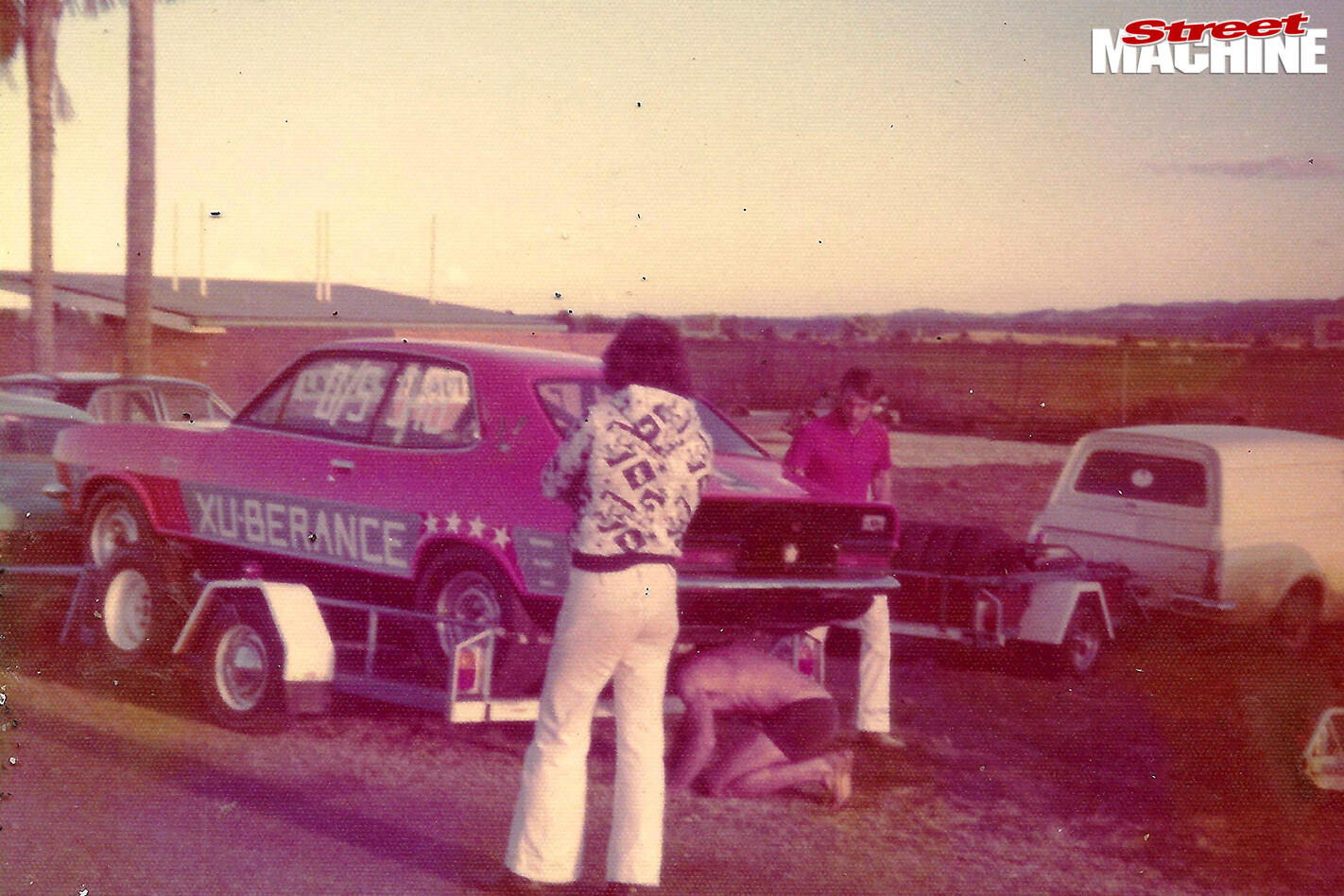 Pretty soon we were looking to go faster. There was this little Datsun called ‘Time Is Tight’ running against us; the owner Gavin Adams had some sponsorship from Lalor Motors (Nissan dealership) and was giving us a real run for our money.
Pretty soon we were looking to go faster. There was this little Datsun called ‘Time Is Tight’ running against us; the owner Gavin Adams had some sponsorship from Lalor Motors (Nissan dealership) and was giving us a real run for our money.
Power wasn’t our problem, traction was. In Stock Eliminator in those days you couldn’t tub the rear; rolling the lips was about as far as you could go. My solution came by way of a pair of M&H speedway slicks on 14×8 HK steel rims.
Wow – what a difference! Low 14s immediately – and a maintenance program that would have broken lesser people, but my mates Pete Warrendorp and Archie McIlroy were stayers. George Wegener showed us how to keep harmonic balancers on the engine most of the time.
I would tow a trailer full of Opel four-speeds, humpy centres with 3.9 gears, and spare axles to every meeting (couldn’t change any of the original running gear for stronger stuff). Flywheels were a challenge as well; at a time when everyone was lightening up, we went with heavy – like 35lb heavy. That engine would just stay up there and you changed gears behind it. If we got four passes without the flywheel coming loose we were ecstatic. Two Christmas trees later, the Torana was returned to the street, and by then the Warrendorp/McIlroy/Digney Morris Minor gasser, Gas Treatment, was nearing completion.
As always, things didn’t always go to plan, and there were frustrating teething problems with the gasser. And what do you know – the Winters were just three weeks away and we didn’t have a competitive race car. Then the penny dropped: Let’s put the Torana back together for one more go; after all, low 14s was still competitive in D/S (no one in the country was quicker at the time). The three-week stint to put it back together was tough, but for the first time ever the car was ready on the Wednesday night before – something we had never achieved before. The car was signwritten, tuned and ready to go.
Now the car belonged to Archie, and he wanted to take it home to show his friends, so the muffler went on (a five-minute job), the SUs were leaned up a little and Archie was off.
That was the last time I ever saw the car in one piece. On the Thursday night some thieving scum skull-dragged the car out of Archie’s yard, and XU-berance was gone.
We did get some of the car back; we dragged the body out of the Petrie Dam. Archie sold it to a speedway guy.
As for the Morrie, it eventually went 13.00@103mph with a stock XU-1 202, triple Strommies, three-speed and 4.11s. But money was tight and I had just got married, so the development of the Morris waned. I became a scrutineer and apprentice announcer at Surfers just so I could stay involved.
LEARNING FROM THE BEST
MILTON Adey was a powerhouse. He raced, he was ANDRA divisional director, and lead announcer at Surfers Paradise drags. He also held down a job and raised his family.
When I started learning the announcing craft under him, there were no computers, so every car was written down by entrant number. Those lists were generated by the girls in scrutineering and taken up to the tower, where about half an hour before racing started Milt and I would pin them to a board set up on a bench in front of us.
The startline would radio the race numbers up to the tower, one of the girls would place the numbers in front of us and we would run down the lists, find the details, tell the story, and call the race and the times. Gee I’m glad the cars were a little slower back then!
Anyway, it was the Ampol Series, and Milton decided he was going to race. Now that in itself didn’t worry me, he’d done that before. But this was the first round of my first Ampol Series, and he’s out the door and racing! I mean, we’ve got Yanks and Keith Williams the track owner all there, and I’m on my own. Panic wasn’t just the name of Bruce Phillips’s Torana funny car – it was my state of mind! Must have done okay though, because when Milt did finally come back into the tower, I received that little smile that only he could give, and we were away.
Milt was always mentoring me; he passed on so many important lessons. His first golden rule was to remember to look at him, to make sure we weren’t talking over each other. Many times I would feel the lightest touch on my shoulder, which meant: You are becoming too loud, too fast, too excited. Most importantly, you are not telling the story. He always was the calming voice. I was the yang, the winder-upper, so to speak. But he never let you lose control; he was the master, the best I’ve ever worked with.
Even today – and Milt is no longer with us – I still get that light touch every now and then. I must confess that I’m not the teacher he was, but I try my best.
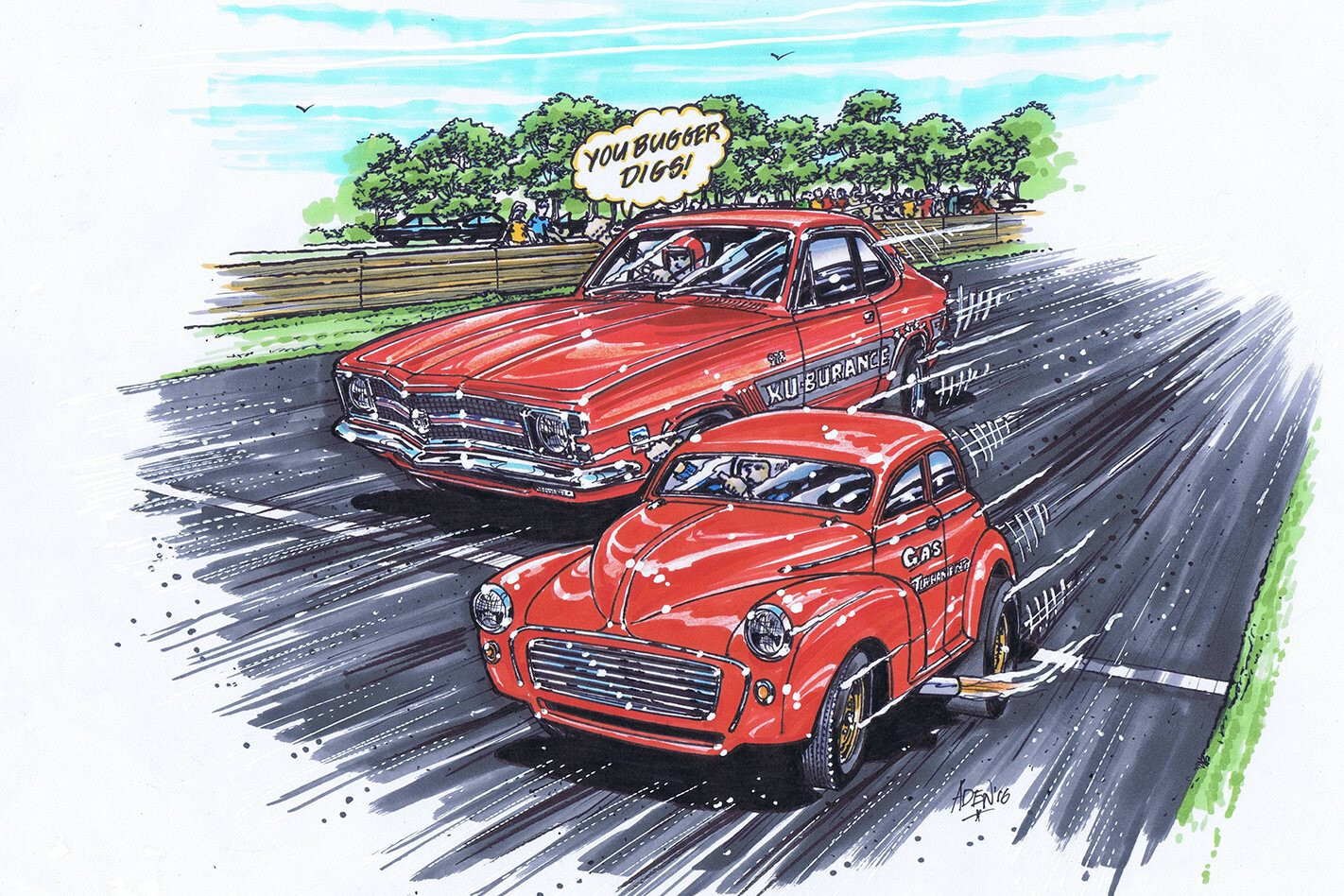
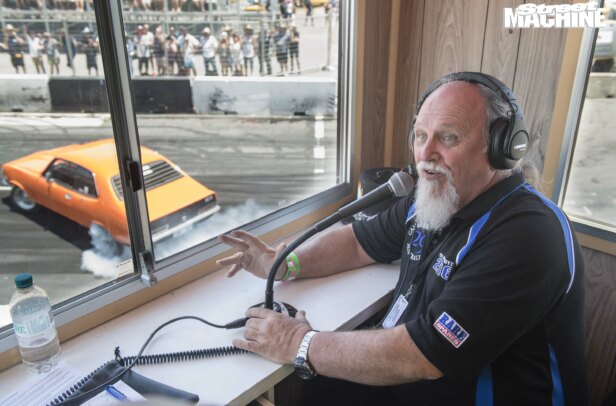
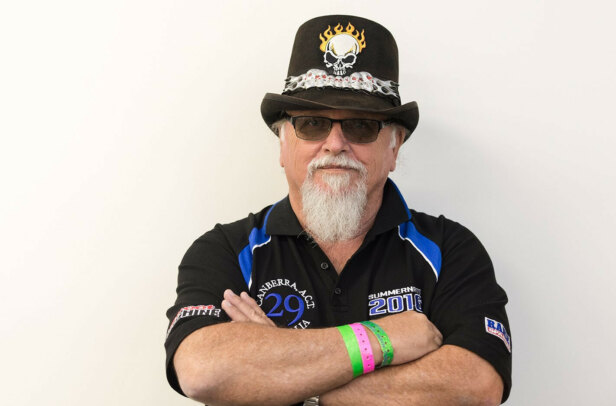
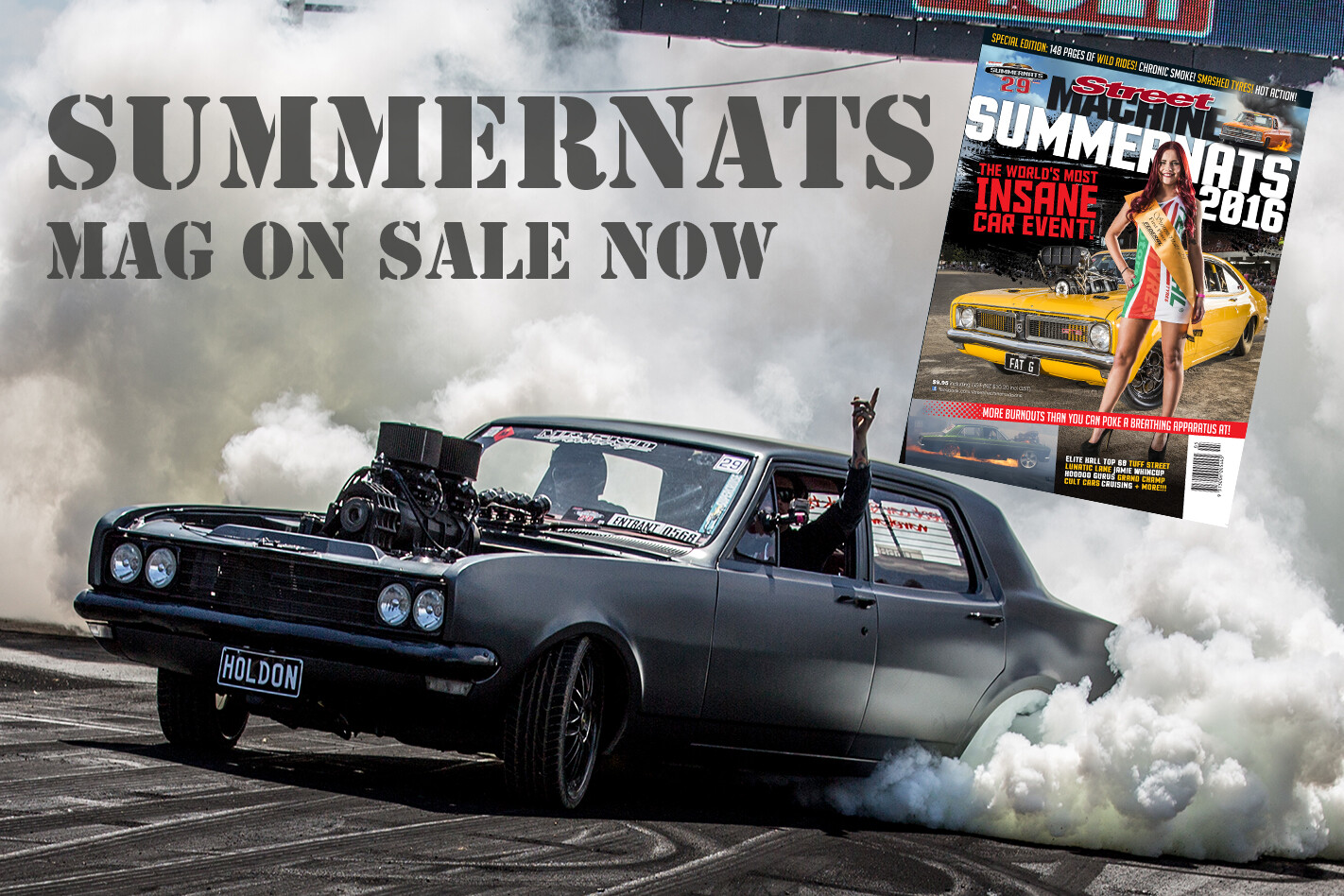
Comments